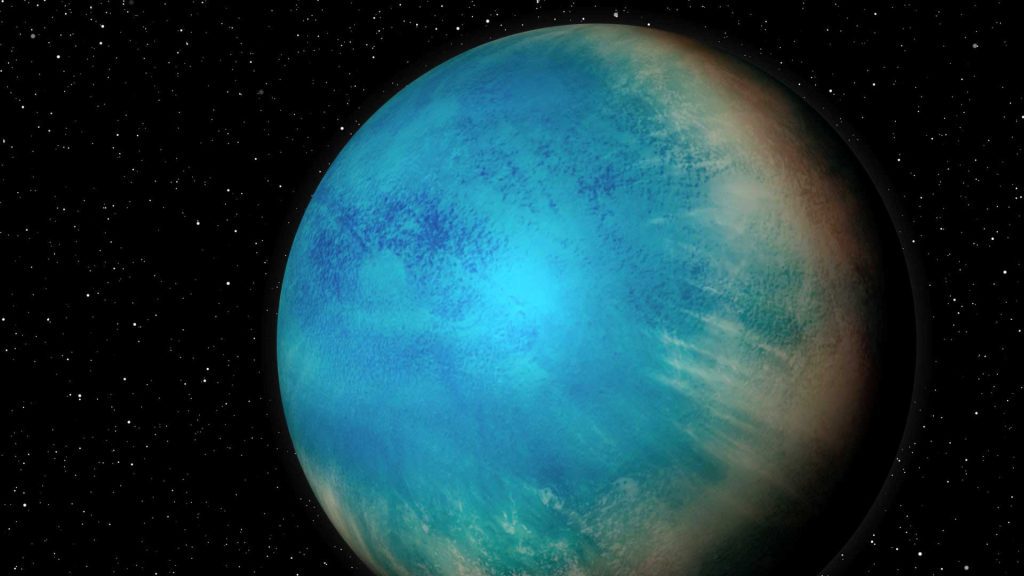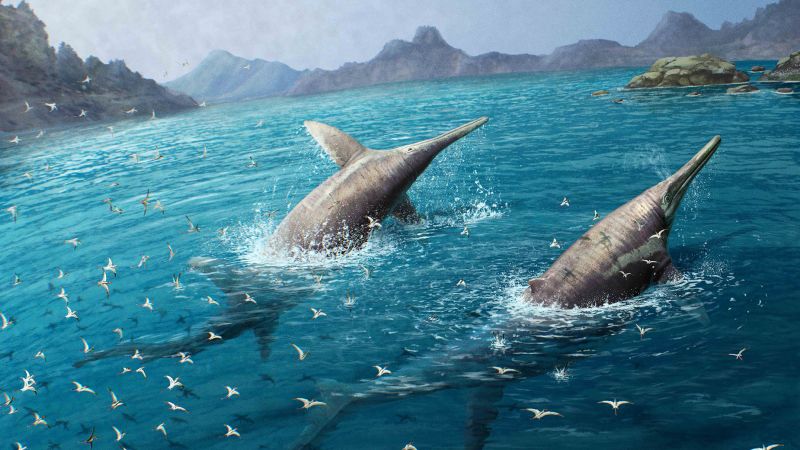
Technische Übersetzung des Exoplaneten TOI-1452 b, ein kleiner Planet, der möglicherweise vollständig von den Tiefen des Ozeans bedeckt ist. Bildnachweis: Benoit Gougeon, Universität Montreal
Mit Hilfe von Instrumenten, die teilweise in Kanada entwickelt wurden, entdeckte ein Team von Astronomen[{“ attribute=““>exoplanet that could be completely covered in water.
An international team of scientists has announced the discovery of TOI-1452 b, an exoplanet orbiting one of two small stars in a binary system located in the Draco constellation about 100 light-years from Earth. The researchers were led by Charles Cadieux, a Ph.D. student at the Université de Montréal and member of the Institute for Research on Exoplanets (iREx).
With a size and mass slightly greater than that of Earth, the exoplanet is located at a distance from its star where its temperature would be neither too hot nor too cold for liquid water to exist on its surface. The astronomers believe it could be an “ocean planet,” a planet completely covered by a thick layer of water. This would make it similar to some of the moons of Jupiter and Saturn.
Cadieux and his team describe the observations that elucidated the nature and characteristics of this unique exoplanet in an article published on August 12 in The Astronomical Journal.

Artistic representation of the surface of TOI-1452 b, which could be an “ocean planet”, i.e. a planet entirely covered by a thick layer of liquid water. Credit: Benoit Gougeon, Université de Montréal
“I’m extremely proud of this discovery because it shows the high calibre of our researchers and instrumentation,” said René Doyon, Université de Montréal Professor and Director of iREx and of the Observatoire du Mont-Mégantic (OMM). “It is thanks to the OMM, a special instrument designed in our labs called SPIRou, and an innovative analytic method developed by our research team that we were able to detect this one-of-a-kind exoplanet.”
It was NASA’s space telescope TESS, which surveys the entire sky in search of planetary systems close to our own, that put the astronomers on the trail of this exoplanet. Based on the TESS signal, which showed a slight decrease in brightness every 11 days, scientists predicted a planet about 70% larger than Earth.
Charles Cadieux belongs to a group of astronomers that does ground follow-up observations of candidates identified by TESS in order to confirm their planet type and characteristics. He uses PESTO, a camera installed on the OMM’s telescope that was developed by Université de Montréal Professor David Lafrenière and his Ph.D. student François-René Lachapelle.
Ein internationales Team von Astronomen hat einen Exoplaneten entdeckt, der vollständig von Wasser bedeckt sein könnte. Bildnachweis: Benoit Gougeon, Universität Montreal
„Das OMM hat eine wichtige Rolle bei der Bestätigung der Art dieses Signals und der Schätzung des Planetenradius gespielt“, erklärte Cadeaux. „Dies war keine Routineprüfung. Wir mussten sicherstellen, dass das von TESS entdeckte Signal tatsächlich von einem Exoplaneten verursacht wurde, der TOI-1452 umkreist, die beiden größten Sterne in diesem Doppelsternsystem.“
Der Zentralstern TOI-1452 ist viel kleiner als unsere Sonne und einer von zwei ähnlich großen Sternen im Doppelsternsystem. Die beiden Sterne umkreisen einander und sind durch einen kleinen Abstand voneinander getrennt – 97 Astronomische Einheiten oder etwa das Zweieinhalbfache des Abstands zwischen Sonne und[{“ attribute=““>Pluto — that the TESS telescope sees them as a single point of light. But PESTO’s resolution is high enough to distinguish the two objects, and the images showed that the exoplanet does orbit TOI-1452, which was confirmed through subsequent observations by a Japanese team.
Ingenuity at work
To determine the planet’s mass, the astronomers then observed the system with SPIRou, an instrument installed on the Canada-France-Hawaii Telescope in Hawai’i. Designed in large part in Canada, SPIRou is ideal for studying low-mass stars such as TOI-1452 because it operates in the infrared spectrum, where these stars are brightest. Even then, it took more than 50 hours of observation to estimate the planet’s mass, which is believed to be nearly five times that of Earth.
Étienne Artigau and Neil Cook, researchers also with iREx at the Université de Montréal, played a key role in analyzing the data. They developed a powerful analytic method capable of detecting the planet in the data collected with SPIRou. “The LBL method [for line-by-line] Es ermöglicht uns, die mit SPIRou gewonnenen Daten von vielen Signalen der Parasiten zu bereinigen und die schwache Signatur von Planeten, wie sie von unserem Team entdeckt wurden, aufzudecken“, erklärt Artigau.
Zum Team gehören auch die Forscher Farbod Jahandar und Thomas Vandal aus Quebec, die über einen Ph.D. Studenten an der Universität von Montreal. Jahandar analysierte die Zusammensetzung des Wirtssterns, was nützlich ist, um die innere Struktur des Planeten einzuschränken, während Vandal an der Analyse der mit SPIRou gesammelten Daten beteiligt war.
Wasserwelt
Obwohl der Exoplanet TOI-1452 b so felsig wie die Erde sein mag, deuten sein Radius, seine Masse und seine Dichte auf eine ganz andere Welt als unsere hin. Die Erde ist im Grunde ein sehr trockener Planet. Obwohl wir ihn manchmal den blauen Planeten nennen, weil etwa 70 % seiner Oberfläche vom Ozean bedeckt sind, macht Wasser tatsächlich nur einen winzigen Prozentsatz seiner Masse aus – weniger als 1 %.
Wasser kann auf einigen Exoplaneten reichlich vorhanden sein. In den letzten Jahren haben Astronomen den Radius und die Masse vieler Exoplaneten bestimmt, deren Größe von der Erde bis zu reicht[{“ attribute=““>Neptune (about 3.8 times larger than Earth). Some of these planets have a density that can only be explained if a large fraction of their mass is made up of lighter materials than those that make up the internal structure of the Earth such as water. These hypothetical worlds have been dubbed “ocean planets.”
“TOI-1452 b is one of the best candidates for an ocean planet that we have found to date,” said Cadieux. “Its radius and mass suggest a much lower density than what one would expect for a planet that is basically made up of metal and rock, like Earth.”
The University of Toronto’s Mykhaylo Plotnykov and Diana Valencia are specialists in exoplanet interior modeling. Their analysis of TOI-1452 b shows that water may make up as much as 30% of its mass, a proportion similar to that of some natural satellites in our Solar System, such as Jupiter’s moons Ganymede and Callisto, and Saturn’s moons Titan and Enceladus.
To be continued…
An exoplanet such as TOI-1452 b is a perfect candidate for further observation with the James Webb Space Telescope, or Webb for short. It is one of the few known temperate planets that exhibit characteristics consistent with an ocean planet. It is close enough to Earth that scientists can hope to study its atmosphere and test this hypothesis. And, in a stroke of good fortune, it is located in a region of the sky that the telescope can observe year-round.
“Our observations with the Webb Telescope will be essential to better understanding TOI-1452 b,” said Doyon who overviewed the conception of James Webb’s component Near Infrared Imager and Slitless Spectrograph (NIRISS). “As soon as we can, we will book time on Webb to observe this strange and wonderful world.”
Reference: “TOI-1452 b: SPIRou and TESS reveal a super-Earth in a temperate orbit transiting an M4 dwarf” by Charles Cadieuxg, René Doyon, Mykhaylo Plotnykov, Guillaume Hébrard, Farbod Jahandar, Étienne Artigau, Diana Valencia, Neil J. Cook, Eder Martioli, Thomas Vandal, Jean-François Donati, Ryan Cloutier, Norio Narita, Akihiko Fukui, Teruyuki Hirano, François Bouchy, Nicolas B. Cowan, Erica J. Gonzales, David R. Ciardi, Keivan G. Stassun, Luc Arnold, Björn Benneke, Isabelle Boisse, Xavier Bonfils, Andrés Carmona, Pía Cortés-Zuleta, Xavier Delfosse, Thierry Forveille, Pascal Fouqué, João Gomes da Silva, Jon M. Jenkins, Flavien Kiefer, Ágnes Kóspál, David Lafrenière, Jorge H. C. Martins, Claire Moutou, J.-D. do Nascimento Jr., Merwan Ould-Elhkim, Stefan Pelletier, Joseph D. Twicken, Luke G. Bouma, Scott Cartwright, Antoine Darveau-Bernier, Konstantin Grankin, Masahiro Ikoma, Taiki Kagetani, Kiyoe Kawauchi, Takanori Kodama, Takayuki Kotani, David W. Latham, Kristen Menou, George Ricker, Sara Seager, Motohide Tamura, Roland Vanderspek and Noriharu Watanabe, 12 August 2022, The Astronomical Journal.
DOI: 10.3847/1538-3881/ac7cea
The article was published on August 12, 2022, in The Astronomical Journal. In addition to Charles Cadieux, René Doyon, Étienne Artigau, Neil Cook, Farbod Jahandar and Thomas Vandal at the Université de Montréal’s iREx, the research team includes Nicolas B. Cowan (iREx, MSI, McGill, Canada); Björn Benneke, Stefan Pelletier and Antoine Darveau-Bernier (iREx, UdeM, Canada); Ryan Cloutier, former member of iREx (Harvard, U.S.); and co-authors from University of Toronto, France, Brazil, the United States, Japan, Spain, Switzerland, Portugal, Hungary, Germany, and Crimea.

„Überall Tierfreund. Aufreizend bescheidener Verfechter der Popkultur. Extremer Bierfanatiker. Social-Media-Fan. Typischer Gamer.“

:quality(85)/cloudfront-us-east-1.images.arcpublishing.com/infobae/FGRRVQSH6NEIDE5OYNDPBPL3JU.jpg)
/cdn.vox-cdn.com/uploads/chorus_asset/file/24016887/STK093_Google_02.jpg)

More Stories
Antike Ausgrabungen führten zur Entdeckung der größten bekannten Meeresreptilien
Ein riesiges uraltes Meeresreptil wurde durch einen Amateur-Fossilienfund identifiziert
Die NASA bestätigt, dass ein Objekt von der Internationalen Raumstation in ein Haus in Naples, Florida, abgestürzt ist